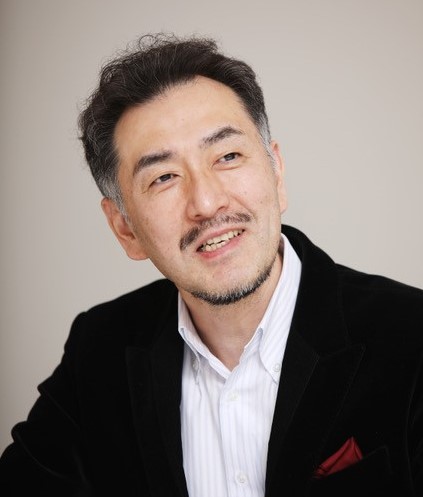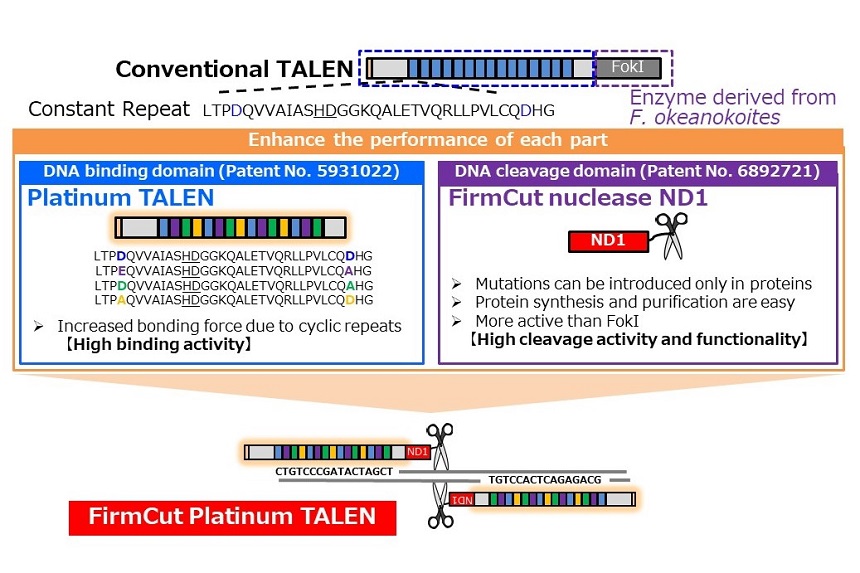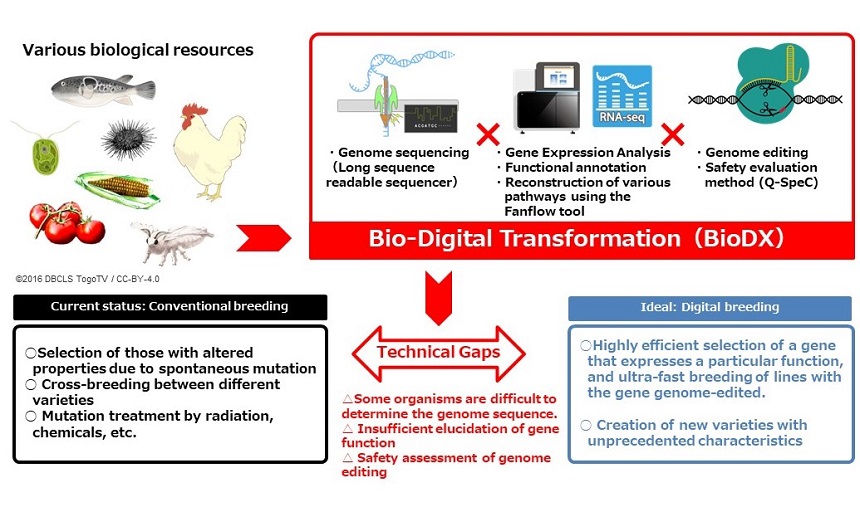On February 1, 2013, Hiroshima University established two new programs: the “Distinguished Professors” (DP) program and the “Distinguished Researchers” (DR) program. Individuals who are part of these programs are recognized as senior and junior faculty members respectively, who are engaged in extraordinarily distinguished research activities.
Interview of Distinguished Professor Takashi Yamamoto

We Aim to Solve Shared Human Challenges in Areas such as Food, Energy, and Diseases by Promoting Industrial Use of Genome Editing Tools Created through Joint Development Efforts.
Developing Inexpensive and Highly Safe Genome Editing Tools
We are conducting research to develop and apply basic technologies for genome editing, which is the process of rewriting the genome (the genetic information of an organism) at will. Potential applications of these technologies include genetic improvement of crops, livestock, and fishery products, use of microorganisms to produce highly functional materials, treatment of diseases, and drug discovery. We provide the technologies we have developed to companies and other organizations for use in joint research where they test them in the field for us, and currently have over 100 partners.
To edit the genome, DNA must be cut in a targeted manner. Research showing that use of DNA cleavage enzymes could increase the efficiency of genetic modification was published around 1990, and I had also been conducting joint research in that area with researchers inside and outside Hiroshima University. Although my team had established methods for producing ZFNs and TALENs, we had not yet developed a highly user-friendly technology accessible to many researchers. In the meantime, two women researchers who later won the Nobel Prize in Chemistry developed CRISPR-Cas9, which acts like “scissors” that allow anyone to easily cut targeted DNA segments, and published their achievements in 2012. However, this technology is very expensive for both industrial and therapeutic use in Japan.
Therefore, that same year, we established the Genome Editing Consortium to develop technology to facilitate genome editing in Japan. While conducting joint research through open innovation with industry partners, we also developed a scissor tool called Platinum TALEN, which consists of an artificial enzyme different from that used in CRISPR-Cas9. More recently, we developed a version with an improved cleavage enzyme, which we named FirmCut Platinum TALEN.
Genome editing tools are being developed all over the world, and are becoming more and more sophisticated; for example, some can cut very effectively and some be used for a variety of organisms. Among these various tools, some of the unique features that FirmCut Platinum TALEN offers are that it is very safe and works well in human cells. For example, CRISPR-Cas9 has a high risk of cutting similar sequences, whereas FirmCut Platinum TALEN enables precise targeting, which opens the possibility of the once-difficult task of genome editing in mammals. We have made it so that researchers who want to use this technology can order it online from anywhere in the world through a dedicated nonprofit organization.

We developed an improved version of the TALEN genome editing tool called Platinum TALEN, and then a more powerful version called FirmCut Platinum TALEN
Bio × Digital Transformation (BioDX) Fusing Genome Editing with Digital Technology
We believe that even when a certain technology already exists, making that technology into something widely accessible will spark innovation. Based on this belief, we launched the Japanese Society for Genome Editing in 2016 to accelerate genome editing research in Japan. The Genome Editing Consortium for Industry-Academia Co-creation, an organization for industry-academia collaboration, was later established as a program of the Japan Science and Technology Agency (JST) based at Hiroshima University. In 2019, the Hiroshima University Genome Editing Innovation Center was established and the university launched a venture with Platinum TALEN as the basic technology. These are all examples of how we are putting great effort into initiatives to connect academia and industry.
In addition, a project to build a BioDX Industry-Academia Co-Creation Center at Hiroshima University was selected to receive support from a JST funding program in 2020, and this has allowed us to further expand our industry-academia co-creation initiatives. For example, we took this opportunity to enhance our joint research on biofuels with Mazda, a car manufacturer based in Hiroshima. Photosynthetic microalgae readily accumulate oil that can be easily used for biofuel, and we are working on genome editing to make these algae more efficient at producing large amounts of oil. We also worked with Toppan, a printing company that also has an AI business, to develop an open platform to support genome editing in order to support R&D by simplifying the data processing involved in genome editing. The human genome consists of as many as 3 billion base pairs, which is one reason why genome editing involves handling of an enormous amount of information. We are trying to improve efficiency by using machine learning to train an AI to determine what parts to modify.
BioDX (digital transformation) technology, which fuses genome editing and digital technology, is also important from the perspective of the SDGs because it will help solve issues in areas such as hunger, health and well-being, and energy. Another role of the BioDX Industry-Academia Co-creation Center is to maximize biological functioning through genome editing to bring us closer to our ideal future society. That is why we are aiming to create the world's most advanced bioeconomic society from here in Hiroshima.

Vision of the BioDX Industry-Academia Co-creation Center
Making Hiroshima a Center for Learning about Genome Editing and Developing Industrial Applications
Some genome-edited crops, livestock, and marine products, such as GABA-rich tomatoes and meaty red sea bream, are already commercially available. At Hiroshima University, we have also succeeded in developing chickens that lay allergen-free eggs, and are now in the process of breeding them. If we can make good products, consumer demand will increase and the market will expand, which will benefit Japan. Consequently, we would like to further promote creation of genome-edited products that consumers demand. We are also working with several groups to research treatments for diseases, so we are striving to make our tools accurate enough to be accessible to anyone for clinical use, and to leverage the technology we have developed at Hiroshima University to make therapeutic genome editing a reality.
Eventually, we would like to create an environment where people from all over Japan will come to Hiroshima University to learn about genome editing, and as we continue to jointly develop technology with companies in Hiroshima, we would like to create a path for people who want to start their own businesses to do so by leveraging research. It would be a shame for an aspiring researcher to give up just because they are worried about their financial future. I want us to continue pursuing initiatives that serve as inspiration that there are dreams to be had in research.

 Home
Home